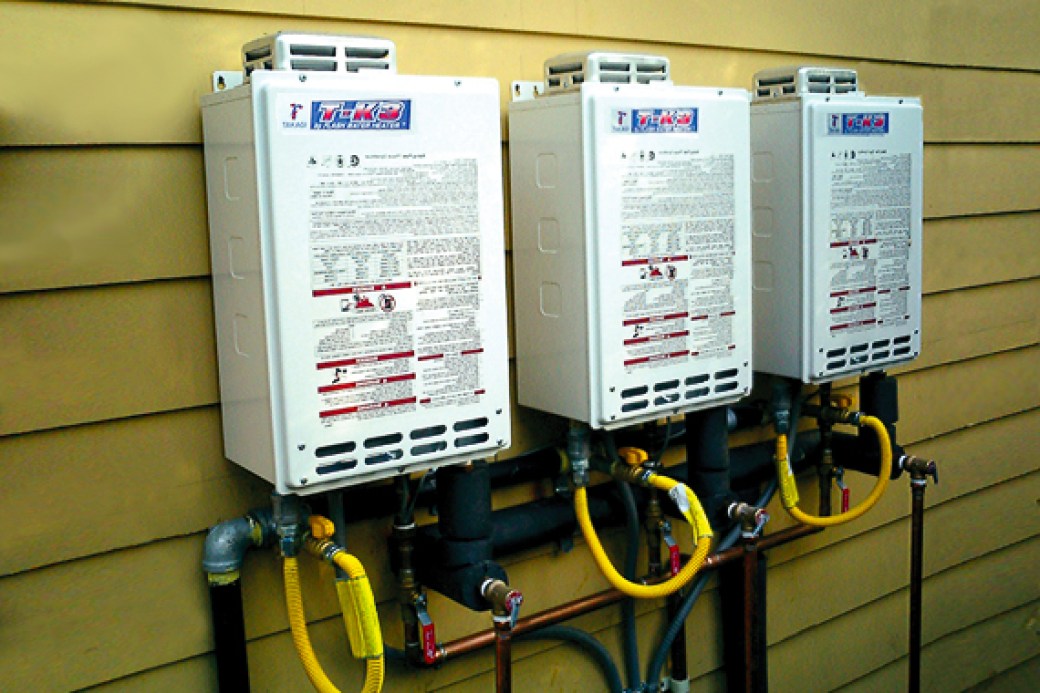If you’re debating replacing your hot water heater with a tankless version, also known as an on-demand water heater, here’s what you need to know to make the right decision.
What’s the Advantage of Going Tankless?
Traditional hot water heaters typically live in your basement and provide gallons of hot water at one time: an 80-gallon tank heats enough water to shower, run a dishwasher, and do a load of laundry simultaneously. But standby energy loss is significant with traditional hot water heaters, and once you’ve exhausted the hot water supply, you’ll wait 20 to 60 minutes for the heater to cook up more.
A tankless water heater produces hot water only when you need it. When you turn on the faucet, water is heated on the spot as it flows through capillary-like pipes heated by either a powerful gas burner or electric coils. (There are no oil-fired on-demand water heaters on the market.)
By bringing hot water close to where it’s needed, you reduce energy loss and increase efficiency by 50% over a conventional hot water tank system, about $165 in annual savings for an average household.
What’s the Downside?
Although a tankless water heater can pump hot water all day, it can’t produce a large amount all at once. And it can snap you out of a hot-shower bliss with the “cold water sandwich effect,” a sudden splash of cold water that results from turning the hot water faucet on and off repeatedly.
A traditional tank heater puts out 7.5 to 9.5 gallons of water per minute (GPM), enough to shower, run the dishwasher, and do a load of laundry all at the same time. The typical tankless water heater, however, puts out only 2.5 to 5 GPM, enough to handle only two uses at a time.
Be warned: Not all flow rates are calculated the same. Energy Star measures GPM based on a 77-degree increase in water temperature needed to heat water, while some companies list their GPM flows at 35- and 45-degree rises. The more heat the water requires, the slower the flow rate.
Possible solution to the "cold water sandwich": Install multiple on-demand units. Because it’s small — about the size of a carry-on suitcase — you can place a tankless water heater along any stretch of pipe: In the attic, basement, closet, or crawlspace. You can install two or three units to serve different parts of the house, or even dedicate a unit for a particular use — say, a washing machine. Multiple on-demand units increase overall energy efficiency.
How Much Do They Cost?
Gas-fired tankless water heater: This system costs $1,500 to buy and install, nearly double the price of a conventional gas water heater, and $575 more than a high-efficiency tank model. In addition, while a conventional water heater typically uses a half-inch gas line, a tankless water heater requires three-quarter-inch pipe. That plumbing change costs from $25 to $40 per foot, potentially adding many hundreds to initial costs. On the bright side, your new energy-efficient unit may qualify for a federal tax credit of up to $300 on purchase and installation through 2013.
Electric tankless water heater: Much cheaper. It can cost as little as $400 installed. But it doesn’t qualify for a tax credit because it is less efficient than gas and is better suited for point-of-use applications, such as instant kitchen hot water, rather than a whole-house system.
Related: More About Tax Credits for Hot Water Heaters
More About Energy (and Money) Savings
- According to the U.S. Dept. of Energy, a tankless water heater is more efficient and uses less energy than a conventional water heater, providing a $25 to $107 in annual savings.
- If your hot water use is low (less than 41 gallons per day), a tankless water heater will be 24% to 34% more efficient.
- If your hot water usage is high (about 86 gallons per day), a tankless water heater is 8% to 14% more energy efficient.
- Installing an on-demand unit at each hot water faucet gives an energy savings of 27% to 50%.
Related: Buyer’s Guide to Hot Water Heaters
